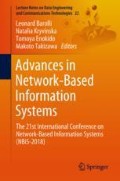Abstract
Machine learning servers with mass storage and computing power is an ideal platform to store, manage, and analyze data and support decision-making. However, the main issue is providing security and privacy to the data, as the data is stored in a public way. Recently, homomorphic data encryption has been proposed as a solution due to its capabilities in performing computations over encrypted data. In this paper, we proposed an encrypted all convolutional net that transformed traditional all convolutional net into a net based on homomorphic encryption. This scheme allows different data holders to send their encrypted data to cloud service, complete predictions, and return them in encrypted form as the cloud service provider does not have a secret key. Therefore, the cloud service provider and others cannot get unencrypted raw data. When applied to the MNIST database, privacy-preserving all convolutional based on homomorphic encryption predict efficiently, accurately and with privacy protection.
Access this chapter
Tax calculation will be finalised at checkout
Purchases are for personal use only
References
Hinton, G.E., Salakhutdinov, R.R.: Reducing the dimensionality of data with neural networks. Science 313(5786), 504–507 (2006)
Krizhevsky, A., Sutskever, I., Hinton, G.E.: ImageNet classification with deep convolutional neural networks. In: International Conference on Neural Information Processing Systems, pp. 1097–1105. Curran Associates Inc. (2012)
Girshick, R., Donahue, J., Darrell, T., et al.: Rich feature hierarchies for accurate object detection and semantic segmentation. In: IEEE Conference on Computer Vision and Pattern Recognition, pp. 580–587. IEEE Computer Society (2014)
He, K., Zhang, X., Ren, S., et al.: Spatial pyramid pooling in deep convolutional networks for visual recognition. IEEE Trans. Pattern Anal. Mach. Intell. 37(9), 1904–1916 (2014)
Szegedy, C., Liu, W., Jia, Y., et al.: Going deeper with convolutions. In: Proceedings of the IEEE Conference on Computer Vision and Pattern Recognition, pp. 1–9 (2015)
Simonyan, K., Zisserman, A.: Very deep convolutional networks for large-scale image recognition. In: Computer Science (2014)
Springenberg, J.T., Dosovitskiy, A., Brox, T., et al.: Striving for simplicity: the all convolutional net. Eprint Arxiv (2014)
Barni, M., Orlandi, C., Piva, A.: A privacy-preserving protocol for neural-network-based computation. In: The Workshop on Multimedia and Security, pp. 146–151. DBLP (2006)
Orlandi, C., Piva, A., Barni, M.: Oblivious neural network computing via homomorphic encryption. EURASIP J. Inf. Secur. 2007(1), 1–11 (2007)
Xie, P., Bilenko, M., Finley, T., et al.: Crypto-nets: neural networks over encrypted data. In: Computer Science (2014)
Dowlin, N., Ran, G.B., Laine, K., et al.: CryptoNets: applying neural networks to encrypted data with high throughput and accuracy. In: Radio and Wireless Symposium, pp. 76–78. IEEE (2016)
Chabanne, H., de Wargny, A., Milgram, J., et al.: Privacy-preserving classification on deep neural network. In: IACR Cryptology ePrint Archive, 2017, p. 35 (2017)
Krizhevsky, A., Sutskever, I., Hinton, G.E.: ImageNet classification with deep convolutional neural networks. In: Advances in Neural Information Processing Systems, pp. 1097–1105 (2012)
Gentry, C.: Fully homomorphic encryption using ideal lattices. In: STOC 2009, vol. 9, no. 4, pp. 169–178 (2009)
Paillier, P.: Public-key cryptosystems based on composite degree residuosity classes. In: Proceedings of the Advances in Cryptology—EUROCRYPT 1999, International Conference on the Theory and Application of Cryptographic Techniques, Prague, Czech Republic, 2–6 May 1999. DBLP, pp. 223–238 (1999)
Elgamal, T.: A public key cryptosystem and a signature scheme based on discrete logarithms. IEEE Trans. Inf. Theory 31(4), 469–472 (1984)
Gu, C.: New Fully Homomorphic Encryption without Bootstrapping (2011)
Halevi, S., Shoup, V.: HElib—An Implementation of Homomorphic Encryption. https://github.com/shaih/HElib/
Ioffe, S., Szegedy, C.: Batch Normalization: Accelerating Deep Network Training by Reducing Internal Covariate Shift, pp. 448–456 (2015)
LeCun, Y., Cortes, C., Burges, C.J.C.: The mnist Database of Handwritten Digits (1998) http://yann.lecun.com/exdb/mnist/
Acknowledgements
This work is supported by National Cryptography Development Fund of China under grant number MMJJ20170112, National Natural Science Foundation of China (Grant Nos. U1636114, 61772550, 61572521), National Key Research and Development Program of China (Grant No. 2017YFB0802000), Natural Science Basic Research Plan in Shaanxi Province of China (Grant Nos. 2018JM6028, 2016JQ6037).
Author information
Authors and Affiliations
Corresponding author
Editor information
Editors and Affiliations
Rights and permissions
Copyright information
© 2019 Springer Nature Switzerland AG
About this paper
Cite this paper
Liu, W., Pan, F., Wang, X.A., Cao, Y., Tang, D. (2019). Privacy-Preserving All Convolutional Net Based on Homomorphic Encryption. In: Barolli, L., Kryvinska, N., Enokido, T., Takizawa, M. (eds) Advances in Network-Based Information Systems. NBiS 2018. Lecture Notes on Data Engineering and Communications Technologies, vol 22. Springer, Cham. https://doi.org/10.1007/978-3-319-98530-5_66
Download citation
DOI: https://doi.org/10.1007/978-3-319-98530-5_66
Published:
Publisher Name: Springer, Cham
Print ISBN: 978-3-319-98529-9
Online ISBN: 978-3-319-98530-5
eBook Packages: Intelligent Technologies and RoboticsIntelligent Technologies and Robotics (R0)

